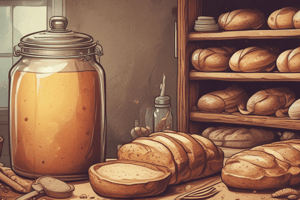Podcast
Questions and Answers
What is the temperature that yeast cells in the dough can withstand?
What is the temperature that yeast cells in the dough can withstand?
- 120°F
- 150°F
- 160°F
- 139°F (correct)
What is the phenomenon that occurs when the heat in the oven increases?
What is the phenomenon that occurs when the heat in the oven increases?
- Bake failure
- Dough collapse
- Oven shrink
- Oven spring (correct)
What is the result of the intense dry heat of the oven forming a skin on the loaf?
What is the result of the intense dry heat of the oven forming a skin on the loaf?
- A more open crumb structure
- A tighter crumb structure (correct)
- A softer crust
- A more even crust color
What is the purpose of scoring the loaves before baking?
What is the purpose of scoring the loaves before baking?
Which type of loaves often do not need to be scored?
Which type of loaves often do not need to be scored?
What is the possible origin of scoring loaves?
What is the possible origin of scoring loaves?
What is the result of the yeast fermenting the dough in an accelerated fashion during oven spring?
What is the result of the yeast fermenting the dough in an accelerated fashion during oven spring?
What is the desired outcome of scoring the loaves before baking?
What is the desired outcome of scoring the loaves before baking?
What is the main difference between the two bâtards in Figure 8.1a?
What is the main difference between the two bâtards in Figure 8.1a?
Why do customers avoid distorted loaves?
Why do customers avoid distorted loaves?
What is the result of scoring a loaf with diagonal cuts?
What is the result of scoring a loaf with diagonal cuts?
Why might a baker score a boule with a cross shape?
Why might a baker score a boule with a cross shape?
What happens when a loaf is underproofed and scored with shallow cuts?
What happens when a loaf is underproofed and scored with shallow cuts?
Why are small rolls often not scored?
Why are small rolls often not scored?
What is the benefit of scoring rolls?
What is the benefit of scoring rolls?
What is the common method of scoring rolls?
What is the common method of scoring rolls?
Why might a baker use shorter or shallower cuts on a boule?
Why might a baker use shorter or shallower cuts on a boule?
What happens when a loaf is overproofed and scored?
What happens when a loaf is overproofed and scored?
Flashcards are hidden until you start studying
Study Notes
Scoring Loaves
- When loaves are loaded into the oven, they undergo a brief stage of dough fermentation, and yeast cells ferment the dough in an accelerated fashion, generating a large amount of CO2 gas.
- This phenomenon is known as oven spring, causing sudden growth in the loaf and tremendous pressure on its exterior.
- If the loaf is not scored, the intensely dry heat of the oven can form a skin that restricts its ability to expand, resulting in a tighter crumb and possible distortion or rupture.
Purpose of Scoring
- Scoring helps the loaves grow in a controlled, attractive manner and ensures an open crumb structure.
- It coaxes the intense gas pressure in the direction desired, allowing the loaf to expand fully without rupturing.
Types of Scoring
- Not all loaves require scoring, such as pan loaves, which are surrounded by the pan and can expand fully without rupturing.
- Scoring can be done with a straight cut, a diagonal cut, or a cross shape, depending on the type of loaf and desired outcome.
Importance of Scoring
- Scoring can make a significant difference in the volume, crumb structure, and overall attractiveness of the loaf.
- If scoring is done carelessly or the pattern used doesn't relieve enough pressure, the bread takes on a distorted shape, limits its expansion, and creates an unappealing exterior appearance.
- Appearance is important, as customers often avoid distorted loaves, even if their eating quality is fine.
Factors to Consider
- Scoring should be adjusted based on the proofing level of the loaf, with underproofed loaves requiring wider or deeper cuts to accommodate further growth.
- Scoring may not be necessary for small rolls, which expand quickly and may not require controlled growth.
- Time and cost considerations should also be factored into the decision to score loaves or rolls.
Studying That Suits You
Use AI to generate personalized quizzes and flashcards to suit your learning preferences.




